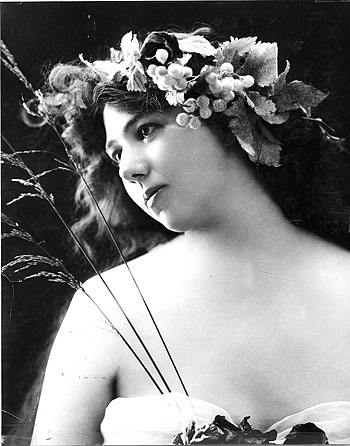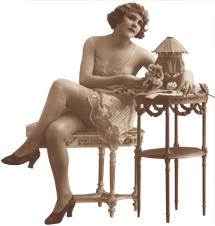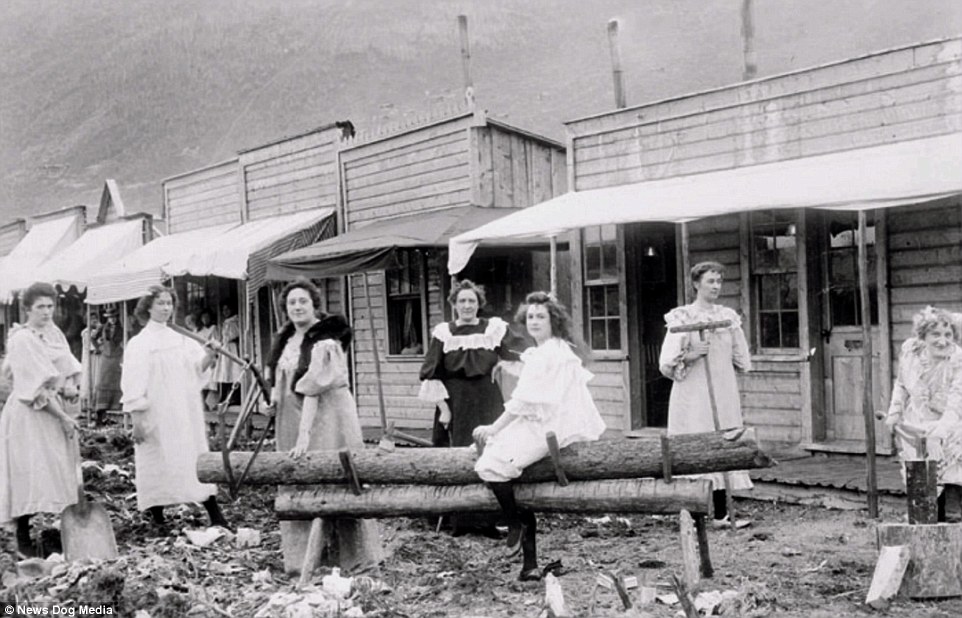Note: This Episode might be a little too crude for some readers. But it is
part of my experience and certainly part of the mystique of the Yukon. Read
it if you will. You have been warned. Livingston Wernecke is a very large
part of Yukon history. His story, very upright man that he was, has been reserved
for a special Episode…
EPISODE 235 YUKON DIARY THE “SPORTING GIRLS” OF KENO CITY (I.E. PROSTITUTES)
alan skeoch
January 2021
NO PICTURES AVAILABLE,,,UNLESS YOU’
CAN FIND A COUPLE. DOES ANYONE HAVE
A PICTURE OF THE KENO CITY SPORTING GIRLS?
WHEN LIVINGSTON WERNECKE MET MADAM VIMY RIDGE
(Below is my interpretation of the night that Livingstone Wernecke, the puritanical mine manager on
Keno Hill met Vimy Ridge, the lead Madam of the sporting girls in Keno City. The dialogue
is fictitious but the event likely happened because it is mentioned so often )
“Did you hear what happened to old man Wernicke last night?:
“Did he fall asleep reading the Bible?”
“Nope.”
“Did he persuade that Swede to sell the Elsa claims cheap?”
“Nope”
Then what happened?”
“Old Man Wernecke paid Vimy Ridge a visit in her whorehouse in Keno City”
“The Madam who hires those sporting girls?”
“Right.”
“I thought he was morally pure.”
“So did one of the boys who was wrapped around a sporting girl at the time.”
“One of our guys?”
“Yep.”
“What happened?”
“Our man looked up, surprised and said ‘So you use this place too, Mr. Wernecke.”
“And?”
“And Wernecke was embarrassed…said nothing….buggered off.”
“Why was he down there? He did not like having the sporting girls
around. Immoral. Giving his boys some bad habits.”
“He went down there to make sure Vimy Ridge allowed his
doctor to check out he girls…keep diseases out of Keno.”
“What diseases?”
“Don’t be naive…the ‘Clap’…you know right well…Old Man Wernecke wanted to
make sure his boys didn’t end up with syphillis or gonorrhoea .”
“I thought he was trying to shut down the whoring in Keno City…drive the
sporting girls down to Mayo …maybe drive them back to Dawson where
they came from.”
“You mean Wernecke has given up his crusade…surrendered to the Madams…”
“Reckon so. We’ve got 800 men up here…most of us single…Wernecke figured he
was fighting a losing battle. Best to keep the girls healthy if he could.”
“What happened to the guy wrapped around the sporting girl?”
“Nothing. Wernecke just left the place. Vimy Ridge let the mine doctor check
out her girls. Everybody seems to have won.”
PROSTITUTION IN KENO CITY
HOW TO TELL IF A MINE IS SUCCESSFUL
In the summer of 1960, Dr. Paterson sent me on a short job to Elliot Lake…the uranium
capital of Canada. Weird job that did not make much sense to me. Can Met UrAnium mine
had been closed down. The stope pillars deep in the bedrock had been pulled. The mine was
collapsing as we conducted our survey through the doomed passageways. I suppose
it was dangerous but I was used to danger, rather liked danger.
We were assigned one of the last mine employees as an underground escort. A rough talking, hard drinking, kind of guy.
He asked me a question while we were sitting on a boulder that had fallen from the
mine ceiling when some roof bolts gave way.
“Alan, do you know how to tell when a mine is successful?”
“No.”
“When the hookers arrive…that’s when we know.”
“Did they arrive here in Elliot Lake?”
“Sure did. Some of them did double duty working in the mess
hall in the daytime and on heir backs at night.”
“Any still around?”
“Are you kidding. They bugger off fast when the mine began to close down.”
FLASH FORWARD TO THE YUKON JOB 1962
In 1962 there were no hookers in Keno City. The great Keno Hill silver/lead mines closed down
in the 1930’s…hit hard by the 1929 Stock Market collapse and the U.S. refusal to buy foreign
silver. The sporting girls were gone.
But they had been in Keno City. Perhaps a dozen of them, maybe a few more They had their cabins
grouped around Keno. The sporting girls did not dominate Keno City…not nearly as dominant as
they had been in Dawson City two decades earlier. some sources said that the Dawson City
prostitutes moved to Keno City once the gold rush ended in Dawson. Possibly so. But age
would have crept up on them. And active sporting girls in 1900 might be in her twenties. That
would make her 40 or 50 operating in Keno City. A little old. The Madams like Bombay
Peggy must have recruited younger girls. Some sources say that big time criminals controlled
the trade. But that flesh business was long gone by 1962. Lots of stories circulated as is
the custom when young single men get together around a campfire. The stories told were
amusing. Rough. Stories taken with a pinch of salt.
Like the story of one sporting girl in Keno who walked around town stark naked except
for her painted toe nails. The story was made more startling when someone observed
her catch and kill a rabbit with her bare feet. The rabbit was to be her dinner that night.
Now who could believe that story? Think about it. Summer time in the Yukon is made
miserable by clouds of mosquitoes so dense that it is unlikely a nude woman would
be walking around town…unless she was insane. Do not rule out that possibility.
Madness among these sporting girls I would not rule out.
Prostitution must be a miserable occupation. Seems to me that The glorification of prostitution is
exaggeration gone wild. My experience? Zero. Never had an inclination even. I can identify closest
to Livingstone Wernicke. Sounds stuffy and boring around a campfire
so most of the time I just listened to the stories. Some were sort of amusing and horrifying at
the same time. Like the story told by Bill Dunn who had a successful sex escapade in Mayo
Landing one night. “I fell asleep afterwards and woke up to find the family sleeping
in the same room. They had been there in the dark.” Some readers will find that story
disgusting. Others amusing. Still others will find it ridiculous…fabricated. Bill Dun had
another story that seemed true. “We we’re sitting in the Power wagon and she tried
to put a knife in me.” Ring of truth there I felt. But….
Which get me back to the sporting girls of Keno City. No glory there. Some Yukon writers
like Pierre Berton (Klondike), Jack London (Call of the Wild), Robert Service (Songs of
a Sourdough) give readers a distorted view of the lives of sporting girls.
I think Dr. Aaro Aho’s book (Hills of Silver) paints the most accurate picture of
the sporting girls of Keno City.
“Up to seven eight sporting girls operated in Keno in the 1920’s and 1930’s. They were
known by names like Vancouver Lil, Jew Jess, Alice, Vimy Ridge, Silver Fox and Nora. and
most had seriously unhappy lives. Some were exceptionally good hearted, others cruel,
some made fortunes, but most worked for fear of their lives under organized vice rings
centred in Vancouver, at least one of them, Silver Fox, was murdered there. (in Keno City)”
This strikes me as a bit odd. Seven or eight sporting girls to service hundreds
of miners seems a little one sided…and exhausting. But Dr. Aho seems to have
researched the situation. Let’s say he missed a dozen. Even so the population
of girls of the line is very small.
“Nora painted her toenails and often went around in the nude….Nora was really tough
and in the 1930’s moved in with one the successful discoverers. She got him to hire
a cook for $7 a day, pushed dope, and helped him go through $17,000in nine months
whereupon his female partner … showed up and put a stop to it.” (P. 132 Aho, Hills of Silver)
“Marie, a good looking woman, came to Keno in 1928, did very well as ‘a girl on the line,”
bought another house, added onto it to make a restaurant, and got her boyfriend Barney to cook
for her. She then started a taxi business, but Barney Barney began to drink up the profits….She
closed the cafe” married several other men but became more and more mentally
disturbed and impoverished. Finally Marie ended up on $20 a month welfare then in
1941 just disappeared one winter. She was tracked to a broken bridge. “She had no next of kin
and no one ever made enquiries or tried to find her.”
So, Aho reduces the sporting girl population to 7or 8 and most had unhappy lives.
There were lots of things to do in Keno City other than pay $3 a trick to a sporting
girl. “ice-skating, tennis, poop,ball game between the mines, villages, steamboat crews,
swimming at Five Mile Lake, and occasionally boxing.” Add the sporting girls and
there seems to have been lots of recreation activities. Which one dominated
Alcohol consumption. “But from all accounts it would
appear Keno’s main recreation was drinking.” (P. 130)
Police? The RCMP sent an undercover man to infiltrate the criminals in Keno City.
He was successful and a police raid followed. Guess who the criminals were?
No mention of the sporting girls. None. But a lot of time and effort was spent trying
to catch the bootleggers. Lots of them during Prohibition. Making hone brew out
of anything they could find that could be distilled. Proof that drinking was the main
activity in Keno Hill.
And that still seems to be the case if you have read these episodes.
alan skeoch
Jan. 2021
Post Script: No mention of sporting girls was made in my diary. But I do remember
one of the guys pointing out an elderly lady in the Chateau Inn, Mayo Landing, and
saying she was once a hooker in Keno. She would be in her late 60’s, perhaps 70’s
in 1962. My memory is fuzzy. Did I see her or just hear about her? Apparently she
returns to Mayo Landing in the summer time. A generous person from whom old timers can
always borrow a few dollars. Warm hearted. Just a memory that I hope was true.
Dawson City prostitutes and their cabins. Not glorious at all.


The Yukon’s dance hall queen
‘The men did not come to the Yukon for the gold; they came to see me,” Klondike Kate Rockwell, perhaps one of the most well-known dance hall girls during the Klondike Gold Rush, is quoted as saying.
‘The men did not come to the Yukon for the gold; they came to see me,” Klondike Kate Rockwell, perhaps one of the most well-known dance hall girls during the Klondike Gold Rush, is quoted as saying.
Klondike Kate was born Kathleen Eloisa Rockwell in Kansas in 1876.
It was a date she would often forget throughout her life, claiming to have been born in 1880, 1882, and even 1892.
As a young woman Kate was beautiful and full of life.
“My father showered luxury on me,” Kate told a biographer, May Mann, later in life. “How could anyone imagine that his beloved and indulged stepdaughter, who was being groomed to take her place as a society leader in the city, was destined to become a variety showgirl and a Yukon dance-hall queen?”
She was expelled from a number of boarding schools because of her behaviour.
Kate loved to dance and flirt, especially with older men.
In New York City, Kate took the name ‘Kitty Phillips’ and got a job as a chorus girl in a variety theatre.
There, Kate got her first taste of what the job entailed: “I was told to sit in one of the boxes. An old schoolmate joined my table. ‘Will you have a bottle of wine?’ he invited. ‘Oh, no, thank you,’ I replied. ‘I do not drink wine. I only drink lemonade. A bottle of wine cost five dollars and the box waiter almost fainted. My commission would have been $1.25 a bottle.”
Later one of the girls told Kate that between acts she was expected to sit and drink with the customers on a percentage commission.
“She also showed me how to pour the drinks into the spittoons when the customers were not watching,” said Kate.
She worked in Washington and Oregon before coming north to the Yukon in 1898.
“I shall never forget my first sight of Dawson,” said Kate. “Front Street, facing the Yukon was a solid line of saloons, dance halls and gambling houses.”
During her first year in Dawson City, Kate made $30,000. One night, while wearing her $1,500 gown from Paris, Kate was crowned Queen of the Yukon. The men fashioned a crown from a tin can, and stuck lit candles on the jagged points. The boys went wild as Kate danced with wax dripping into her hair.
While in Dawson Kate fell in love with a Greek waiter named Alexander Pantages.
She supported him for five years as he worked his way up in the theatre.
He sent Kate to Texas for a year to perform and make money. While Kate was gone Alexander met and married a younger girl from the “right side of the tracks.” Heartbroken, Kate sued Alexander for breach of promise to marry her.
“The woman declares that by her earnings as a vaudeville performer in the Klondike during the early strike she enabled Pantages in five years to jump from poverty to riches, from a waiter in a dance hall in Dawson to the position of theatre magnate,” reported the Dawson Daily News in June 1905.
The case was settled out of court, leaving Kate with a settlement of between $5,000 and $60,000, depending on the source.
In 1933, she married John Matson and the pair returned to Dawson City for their honeymoon.
Matson remained in the Klondike and continued mining; he and Kate rarely saw each though they wrote two letters each year.
In 1946, one of Matson’s letters did not arrive on schedule Kate began to worry and soon after his body was found frozen about 12 kilometres from his remote cabin.
Later, Kate settled in Oregon and married twice before passing away peacefully in 1957, at age 80.
The MacBride Museum has a dress, purse and wrap that were owned by the legendary dance hall girl in its collection.
This column is provided by the MacBride Museum of Yukon History. Each week it will explore a different morsel of Yukon’s modern history. For more information, or to comment on anything in this column e-mail lchalykoff@macbridemuseum.com.



